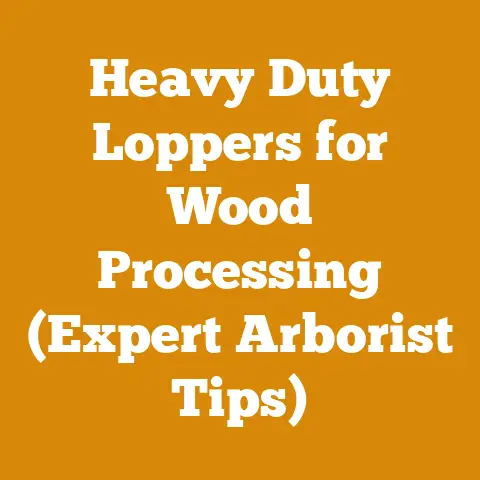White Oak Tree Fall Cleanup (Expert Tips for Efficient Leaf Management)
Alright, let’s dive right in!
Remember that scene in “The Lord of the Rings” where the Ents, the tree shepherds, finally decide to take action? It’s a powerful image of nature’s potential and the importance of understanding wood. Today, we’re not marching on Isengard, but we are tackling a challenge many of us face: the post-autumn cleanup after a majestic white oak drops its leaves. It’s more than just raking; it’s about efficient leaf management.
As someone who’s spent years felling trees, milling lumber, and splitting firewood, I’ve learned that even seemingly simple tasks like leaf cleanup can be optimized with the right knowledge and techniques. I’m going to share my expert tips, focusing on turning what could be a chore into an opportunity to improve your property and even create valuable resources. Let’s get started!
White Oak Tree Fall Cleanup: Expert Tips for Efficient Leaf Management
Understanding the White Oak’s Leaf Drop
Before we even think about rakes and tarps, let’s understand our adversary: the white oak (Quercus alba). White oaks are known for their beautiful fall foliage, but that beauty comes at a price: a lot of leaves.
- Leaf Volume: A mature white oak can drop several cubic yards of leaves, easily overwhelming a small yard.
- Decomposition Rate: White oak leaves are relatively slow to decompose compared to some other species. This is due to their high lignin content, a complex polymer that makes them more resistant to breakdown.
- Acidity: White oak leaves, like many oak varieties, can be slightly acidic. This can be beneficial in some gardens but detrimental in others, depending on the soil pH.
I remember one year, after a particularly heavy leaf drop, my neighbor spent weeks just raking leaves into massive piles. He ended up with so many bags that the garbage truck groaned under the weight. That’s when I realized there had to be a better way.
Strategic Planning: Turning a Problem into an Opportunity
The key to efficient leaf management is strategic planning. Instead of just reacting to the leaf drop, think about how you can use those leaves to your advantage.
Assessing Your Needs and Resources
- Composting: Can you compost the leaves? Composting is an excellent way to recycle organic matter and create valuable soil amendment.
- Mulching: Can you use the leaves as mulch? Mulching can suppress weeds, retain moisture, and improve soil health.
- Disposal: If composting or mulching isn’t feasible, you’ll need a plan for disposal. Check with your local municipality for leaf collection programs or composting facilities.
Creating a Realistic Timeline
- Leaf Drop Duration: White oaks typically drop their leaves over several weeks, so plan accordingly.
- Cleanup Schedule: Break the cleanup into manageable chunks. Don’t try to do it all at once.
- Weather Considerations: Factor in weather conditions. Raking wet leaves is much harder than raking dry leaves.
I learned this the hard way. One year, I waited too long to start the cleanup, and a sudden rainstorm turned my leaf piles into a soggy, matted mess. It took twice as long to clean up, and my back paid the price.
Tool Selection: Choosing the Right Equipment for the Job
Having the right tools can make a huge difference in efficiency and effort.
Rakes
- Leaf Rakes: Choose a lightweight leaf rake with flexible tines. Wider rakes cover more ground but can be harder to maneuver.
- Metal Rakes: For heavier, matted leaves, a metal rake can be more effective.
- Adjustable Rakes: Adjustable rakes allow you to change the width of the rake to suit different tasks.
Leaf Blowers
- Electric Leaf Blowers: Electric leaf blowers are quieter and more environmentally friendly than gas-powered blowers.
- Gas-Powered Leaf Blowers: Gas-powered leaf blowers are more powerful and portable but require more maintenance.
- Backpack Leaf Blowers: Backpack leaf blowers are ideal for large properties, as they distribute the weight evenly.
Leaf Mulchers
- Electric Leaf Mulchers: Electric leaf mulchers shred leaves into small pieces, making them easier to compost or use as mulch.
- Gas-Powered Leaf Mulchers: Gas-powered leaf mulchers are more powerful and can handle larger volumes of leaves.
Tarps and Carts
- Tarps: Tarps are useful for collecting and transporting large piles of leaves.
- Leaf Carts: Leaf carts make it easier to move leaves around your property.
- Wheelbarrows: Wheelbarrows are versatile and can be used for a variety of tasks, including leaf cleanup.
I’ve found that a combination of tools works best. I use a leaf blower to gather leaves into piles, then a tarp to drag them to the compost bin.
Composting White Oak Leaves: A Step-by-Step Guide
Composting is a great way to recycle white oak leaves and create valuable soil amendment.
Building a Compost Pile
- Location: Choose a well-drained location that is easily accessible.
- Size: The compost pile should be at least 3 feet by 3 feet by 3 feet to generate enough heat for decomposition.
- Materials: Combine brown materials (leaves, twigs, paper) with green materials (grass clippings, food scraps).
Layering the Materials
- Brown Layer: Start with a layer of brown materials, such as leaves.
- Green Layer: Add a layer of green materials, such as grass clippings.
- Repeat: Repeat the layers until the compost pile is the desired size.
Maintaining the Compost Pile
- Moisture: Keep the compost pile moist but not soggy.
- Turning: Turn the compost pile regularly to aerate it.
- Temperature: The compost pile should reach a temperature of 130-160°F to kill pathogens and weed seeds.
Accelerating Decomposition
- Nitrogen Boost: Adding a nitrogen source, such as blood meal or urea, can speed up decomposition.
- Compost Activators: Compost activators contain microorganisms that help break down organic matter.
- Shredding: Shredding the leaves before composting can also speed up decomposition.
I once tried composting an entire pile of unshredded oak leaves. It took over a year for them to break down. Now, I always shred the leaves before composting, and the process is much faster.
Mulching with White Oak Leaves: Benefits and Best Practices
Mulching with white oak leaves can suppress weeds, retain moisture, and improve soil health.
Preparing the Leaves
- Shredding: Shred the leaves before mulching to prevent them from matting together and blocking air and water.
- Composting (Optional): Partially composting the leaves before mulching can reduce their acidity.
Applying the Mulch
- Thickness: Apply a 2-4 inch layer of mulch around plants.
- Distance from Stems: Keep the mulch a few inches away from plant stems to prevent rot.
- Timing: Apply mulch in the fall or spring.
Plants That Benefit from Oak Leaf Mulch
- Acid-Loving Plants: Azaleas, rhododendrons, and blueberries thrive in acidic soil and benefit from oak leaf mulch.
- Vegetable Gardens: Oak leaf mulch can suppress weeds and retain moisture in vegetable gardens.
- Flower Beds: Oak leaf mulch can add organic matter to flower beds and improve soil health.
I’ve seen firsthand how oak leaf mulch can transform a garden. My neighbor used to struggle with weeds in his vegetable garden, but after he started using oak leaf mulch, the weeds disappeared, and his plants thrived.
Disposal Options: When Composting and Mulching Aren’t Enough
If you can’t compost or mulch all of your white oak leaves, you’ll need a plan for disposal.
Municipal Leaf Collection Programs
- Curbside Pickup: Many municipalities offer curbside leaf pickup programs.
- Drop-Off Centers: Some municipalities have drop-off centers where you can dispose of leaves.
- Regulations: Check with your local municipality for regulations regarding leaf disposal.
Composting Facilities
- Commercial Composting Facilities: Commercial composting facilities accept leaves and other organic waste.
- Fees: Commercial composting facilities typically charge a fee for disposal.
Other Disposal Options
- Burning: Burning leaves may be allowed in some areas, but it is generally discouraged due to air pollution.
- Landfilling: Landfilling leaves is a last resort, as it takes up valuable landfill space.
I remember one year when the municipal leaf collection program was canceled due to budget cuts. Everyone was scrambling to find a way to dispose of their leaves. That’s when I realized the importance of having a backup plan.
Workflow Optimization: Maximizing Efficiency in Leaf Cleanup
Even with the right tools and a solid plan, there’s always room for improvement in efficiency.
Zoning Your Yard
- Divide and Conquer: Divide your yard into zones and tackle one zone at a time.
- Prioritize High-Traffic Areas: Focus on high-traffic areas first, such as walkways and driveways.
- Consider Wind Direction: Work with the wind direction to avoid blowing leaves back into areas you’ve already cleaned.
Streamlining the Collection Process
- Efficient Raking Techniques: Use long, sweeping strokes to gather leaves into piles.
- Strategic Leaf Blower Use: Use a leaf blower to gather leaves into piles quickly and efficiently.
- Tarp and Cart Placement: Position tarps and carts strategically to minimize the distance you have to carry leaves.
Reducing Handling Time
- Shredding On-Site: Shred leaves on-site to reduce their volume and make them easier to handle.
- Direct Composting: Compost leaves directly in the garden to eliminate the need for transportation.
- Minimize Bagging: Avoid bagging leaves whenever possible. Use tarps or carts instead.
I’ve found that zoning my yard and streamlining the collection process can save me hours of work. It’s all about working smarter, not harder.
Safety Considerations: Protecting Yourself During Leaf Cleanup
Leaf cleanup may seem like a harmless task, but it’s important to take safety precautions.
Personal Protective Equipment (PPE)
- Gloves: Wear gloves to protect your hands from blisters and cuts.
- Eye Protection: Wear eye protection to protect your eyes from dust and debris.
- Dust Mask: Wear a dust mask to protect your lungs from dust and mold spores.
- Hearing Protection: Wear hearing protection when using a leaf blower.
- Proper Footwear: Wear sturdy shoes or boots to prevent slips and falls.
Lifting Techniques
- Bend Your Knees: Bend your knees and keep your back straight when lifting heavy objects.
- Keep the Load Close: Keep the load close to your body to reduce strain on your back.
- Avoid Twisting: Avoid twisting your body while lifting.
Equipment Safety
- Read the Manual: Read the manual for all equipment before using it.
- Maintain Equipment: Maintain equipment properly to ensure safe operation.
- Be Aware of Surroundings: Be aware of your surroundings when using equipment.
- Never Modify Equipment: Never modify equipment in any way.
I once saw someone trip and fall while carrying a heavy bag of leaves. He injured his back and was out of commission for weeks. That’s a stark reminder of the importance of safety.
Dealing with Common Challenges
Even with the best planning, you’re bound to encounter challenges during leaf cleanup.
Wet Leaves
- Raking: Raking wet leaves is more difficult than raking dry leaves. Use a metal rake for heavier, matted leaves.
- Leaf Blower: Leaf blowers are less effective on wet leaves.
- Drying: Allow wet leaves to dry before attempting to clean them up.
Large Volume of Leaves
- Break It Down: Break the cleanup into manageable chunks.
- Enlist Help: Enlist the help of family members or friends.
- Hire a Professional: Consider hiring a professional if you can’t handle the volume of leaves yourself.
Limited Space for Composting
- Vertical Composting: Use a vertical composter to maximize space.
- Community Composting: Participate in a community composting program.
- Vermicomposting: Use worms to compost leaves in a small space.
Acidic Soil Concerns
- Lime: Add lime to the soil to neutralize the acidity.
- Composting: Composting leaves before mulching can reduce their acidity.
- Choose Plants Wisely: Choose plants that tolerate acidic soil.
I remember one year when I was overwhelmed by the volume of leaves in my yard. I ended up hiring a professional to help me out. It was worth every penny.
Current Trends and Best Practices
The world of leaf management is constantly evolving. Here are some current trends and best practices:
Sustainable Leaf Management
- Leave the Leaves: Consider leaving some leaves on your lawn to provide habitat for beneficial insects and improve soil health.
- Electric Equipment: Use electric leaf blowers and mulchers to reduce emissions.
- Composting: Compost leaves instead of sending them to the landfill.
Technological Advancements
- Robotic Leaf Cleaners: Robotic leaf cleaners are becoming more affordable and efficient.
- Smart Composting Systems: Smart composting systems monitor temperature and moisture levels to optimize decomposition.
- Leaf Mulching Mowers: Leaf mulching mowers shred leaves into small pieces and return them to the lawn as fertilizer.
Community Initiatives
- Leaf Swaps: Organize a leaf swap with neighbors to share resources and reduce waste.
- Community Composting Programs: Participate in community composting programs to compost leaves collectively.
- Educational Workshops: Attend educational workshops to learn about sustainable leaf management practices.
I’m excited about the potential of robotic leaf cleaners. Imagine a future where you can just set the robot loose and let it take care of the leaf cleanup for you!
Case Studies: Successful Leaf Management Projects
Let’s look at some real-world examples of successful leaf management projects.
Case Study 1: A Suburban Homeowner’s Composting Success
- Challenge: A suburban homeowner with a small yard wanted to compost their white oak leaves but had limited space.
- Solution: The homeowner used a vertical composter and shredded the leaves before composting. They also added a nitrogen source to speed up decomposition.
- Results: The homeowner was able to compost all of their leaves and create valuable soil amendment for their garden.
Case Study 2: A Community’s Leaf Recycling Program
- Challenge: A community wanted to reduce the amount of leaves sent to the landfill.
- Solution: The community established a leaf recycling program with curbside pickup and a composting facility.
- Results: The community reduced the amount of leaves sent to the landfill by 50% and created a valuable compost product for residents.
Case Study 3: A Landscaper’s Efficient Leaf Cleanup System
- Challenge: A landscaper needed to clean up leaves quickly and efficiently for their clients.
- Solution: The landscaper used a combination of leaf blowers, tarps, and a leaf mulcher. They also trained their employees on efficient raking techniques.
- Results: The landscaper was able to reduce their leaf cleanup time by 25% and increase their profitability.
These case studies demonstrate that with the right planning and techniques, anyone can successfully manage white oak leaves.
My Personal Experience: A Leaf Cleanup Transformation
Let me share a personal story. For years, leaf cleanup was a dreaded chore for me. I’d spend hours raking leaves, only to have them blow back into my yard the next day. I felt like I was fighting a losing battle.
Then, I started experimenting with different techniques. I learned about composting, mulching, and workflow optimization. I invested in better tools and equipment. Slowly but surely, I transformed my leaf cleanup routine.
Now, I actually enjoy leaf cleanup. I see it as an opportunity to improve my property and create valuable resources. I’ve even started teaching my neighbors how to manage their leaves more efficiently.
It’s amazing what you can accomplish with a little knowledge and effort.
Global Perspectives: Leaf Management Around the World
Leaf management practices vary widely around the world, depending on climate, culture, and resources.
Japan: Burning Leaves for Fertilizer
In some rural areas of Japan, farmers burn leaves to create a nutrient-rich ash that is used as fertilizer.
Netherlands: Leaf Collection for Renewable Energy
In the Netherlands, some municipalities collect leaves and use them to generate renewable energy.
India: Leaf Plates and Bowls
In India, leaves are often used to make disposable plates and bowls.
Germany: Composting and Mulching
In Germany, composting and mulching are widely practiced to recycle leaves and reduce waste.
It’s fascinating to see how different cultures approach leaf management. It reminds us that there are many ways to solve the same problem.
The Future of Leaf Management
The future of leaf management is likely to be driven by sustainability, technology, and community involvement.
Sustainability
- Zero Waste: The goal is to minimize waste and recycle leaves whenever possible.
- Carbon Sequestration: Leaves can be used to sequester carbon in the soil.
- Biodiversity: Leaving some leaves on the ground can support biodiversity.
Technology
- Robotics: Robotic leaf cleaners will become more common and efficient.
- Smart Systems: Smart composting systems will optimize decomposition.
- Data Analytics: Data analytics will be used to track leaf collection and disposal patterns.
Community Involvement
- Education: Public education campaigns will promote sustainable leaf management practices.
- Collaboration: Communities will work together to share resources and reduce waste.
- Citizen Science: Citizen scientists will collect data on leaf drop and decomposition rates.
The future of leaf management is bright. By embracing sustainability, technology, and community involvement, we can create a more efficient and environmentally friendly system.
Takeaways and Next Steps
Alright, we’ve covered a lot of ground. Here are the key takeaways:
- Plan Strategically: Assess your needs, resources, and create a realistic timeline.
- Choose the Right Tools: Select tools that are appropriate for your yard and your abilities.
- Compost or Mulch: Compost or mulch leaves whenever possible to recycle organic matter.
- Optimize Workflow: Streamline the collection process and reduce handling time.
- Prioritize Safety: Protect yourself from injury by wearing PPE and using proper lifting techniques.
- Embrace Sustainability: Use sustainable leaf management practices to protect the environment.
So, what are your next steps?
- Assess your yard and resources.
- Create a leaf management plan.
- Gather the necessary tools and equipment.
- Start cleaning up those leaves!
Remember, leaf cleanup doesn’t have to be a chore. With the right knowledge and techniques, you can turn it into an opportunity to improve your property and create valuable resources. Now, get out there and make those leaves work for you!
Good luck, and happy leaf managing!






